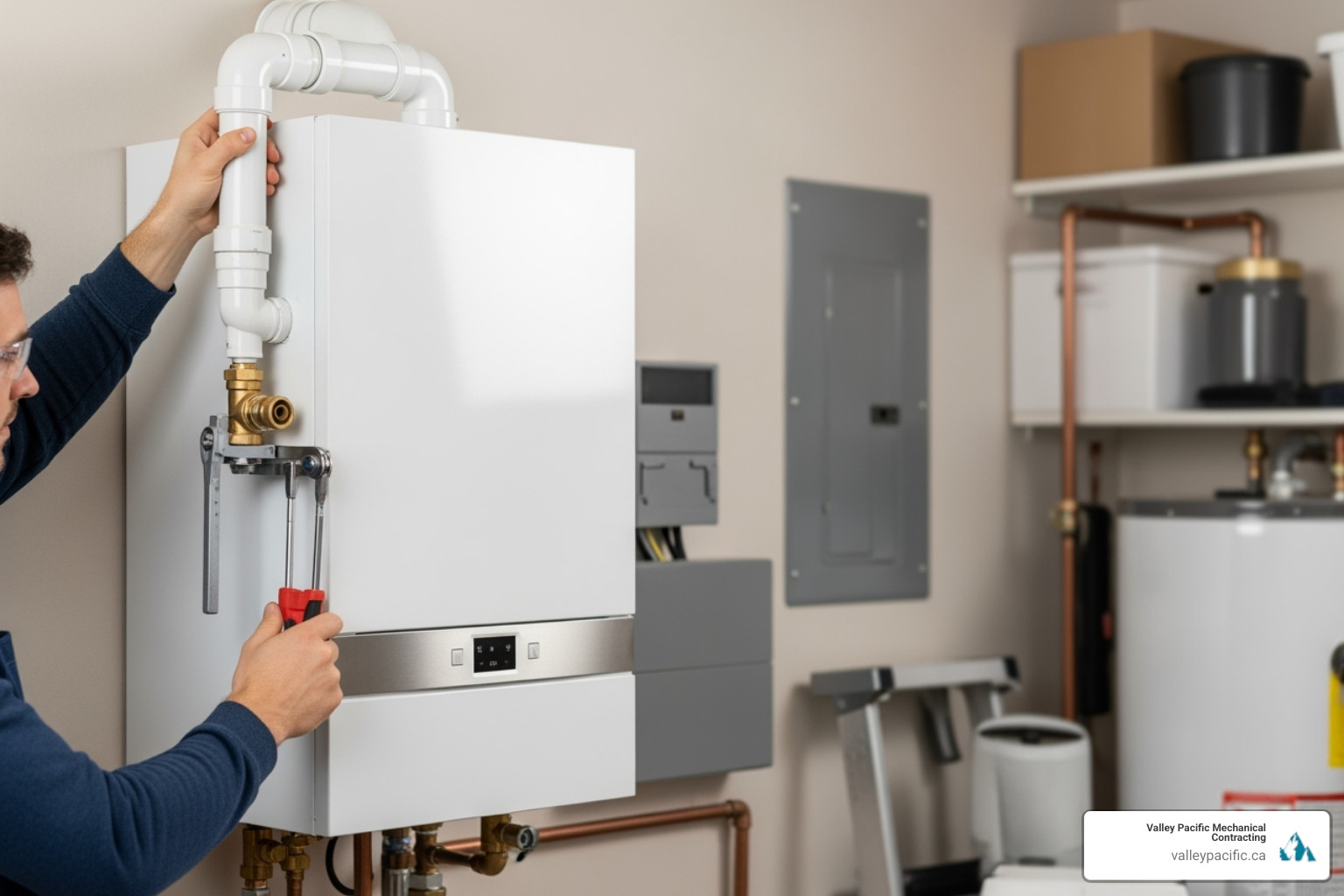Installing a Condensing Boiler: Tips for a Flawless Setup


Why Professional Installation Makes All the Difference
Condensing boiler installation requires careful planning and expert execution to achieve the high efficiency these modern systems are designed for. Unlike older boiler types, condensing boilers capture heat from water vapor in exhaust gases, achieving efficiency ratings of 90% or higher - but only when properly installed.
Key Installation Requirements for Condensing Boilers:
- Direct venting system - PVC or CPVC pipes for cooler exhaust gases
- Condensate drain - Acidic water byproduct needs proper disposal
- Specific clearances - 18" front access, proper wall mounting requirements
- Low return temperatures - System must operate below 55°C for optimal condensing
- Professional assessment - Gas, electrical, and plumbing connections require certified technicians
Starting January 1, 2025, all commercial boilers in apartment and condo buildings must have an efficiency rating of 90% or higher, making condensing boilers the new standard. This shift reflects their superior performance - they can reduce operating costs by up to a third compared to older gas boilers.
The installation process involves more than just connecting pipes. Condensing boilers create acidic condensate that needs neutralization, require specific venting materials due to cooler exhaust temperatures, and must be sized and controlled properly to maintain their condensing mode of operation.
A proper installation by qualified technicians ensures your new boiler operates at peak efficiency, prevents costly callbacks, and maintains manufacturer warranties. The complexity of gas, electrical, and plumbing connections - combined with strict building codes - makes professional installation essential for both safety and performance.
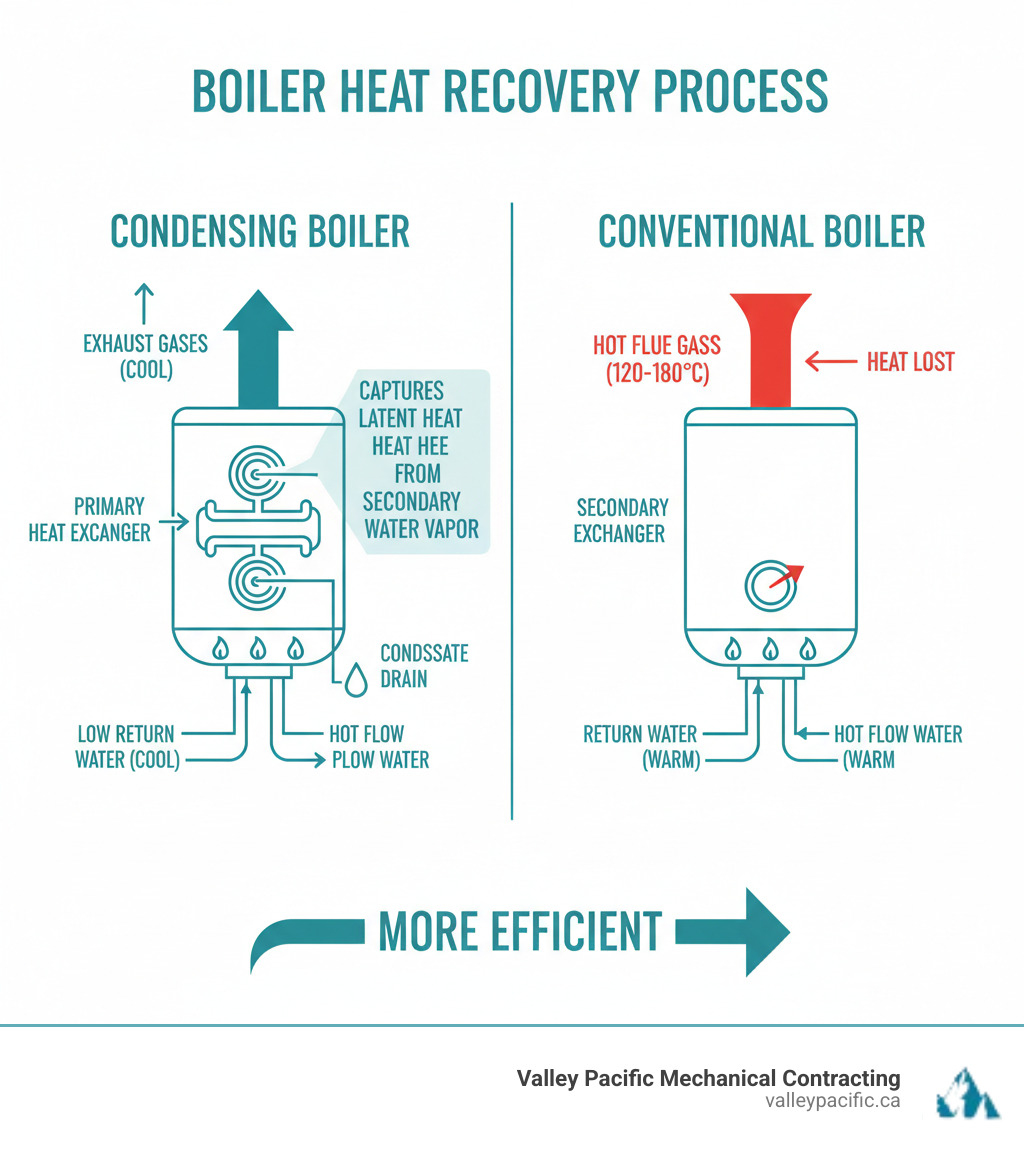
Quick Condensing boiler installation terms:
Understanding Condensing vs. Non-Condensing Boilers
Understanding the difference between condensing and non-condensing boilers is simple: one captures valuable heat that the other wastes.
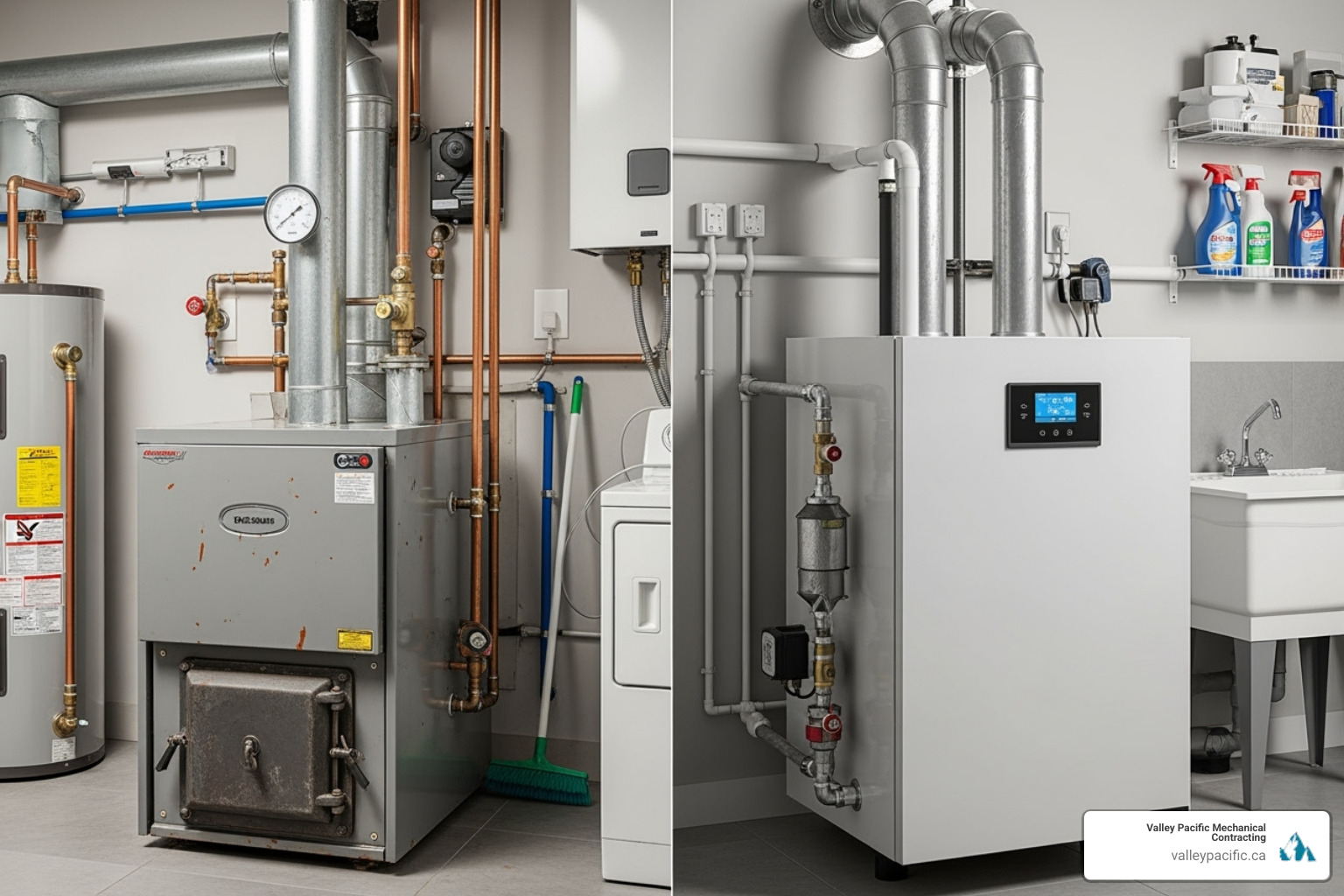
Traditional non-condensing boilers burn fuel to heat water and send hot exhaust gases straight up the chimney, losing valuable heat energy. These older systems typically achieve 70-85% efficiency, meaning up to 30% of your heating costs are wasted. Their hot exhaust requires heavy-duty steel venting.
Condensing boiler installation uses a smarter approach. These systems capture heat from exhaust gases by cooling them until the water vapor inside condenses back into liquid, releasing even more heat. This recovery process allows them to achieve 90% efficiency or higher. Their cooler exhaust permits the use of flexible venting materials like PVC, and their compact, often wall-mounted design offers more placement options.
Here's how they stack up:
| Feature | Non-Condensing Boilers | Condensing Boilers |
|---|---|---|
| Efficiency (AFUE) | 70-85% | 90-99% |
| Venting | High-temperature (steel) chimney/flue | Low-temperature (PVC, CPVC, PP, SS) direct vent, often through wall or roof |
| Condensate Drain | Not required | Required for acidic liquid byproduct |
| Size/Footprint | Typically larger, floor-standing | Often compact, wall-mounted |
How Condensing Boilers Achieve Superior Efficiency
The key is latent heat recovery. When fuel burns, it creates hot exhaust containing water vapor. Old boilers waste this vapor and its heat up the flue. Condensing boilers use a secondary heat exchanger to cool the exhaust gases below their dew point, causing the water vapor to condense. This process releases latent heat, which is used to pre-heat the return water before it reaches the main burner. The burner then works less, boosting efficiency.
As a result, many condensing boilers earn the ENERGY STAR® label with ratings of 95% AFUE or higher. To achieve this, return water temperatures must be kept low—ideally 55°C (131°F) or below—to ensure condensation occurs.
The New Standard for Boiler Installations
The industry is shifting to high-efficiency systems. Starting January 1, 2025, new regulations mandate that commercial boilers in apartment and condo buildings achieve 90% efficiency or higher, effectively phasing out atmospheric boilers for these uses. This move is both environmentally and economically sound, as condensing boilers reduce carbon footprints and can cut heating costs by up to a third.
For property owners, this means planning ahead. Preparing your home for a new boiler is key to meeting these new standards. Modern condensing boilers not only meet but exceed these regulations, providing reliable, efficient heating.
Key Pre-Installation Considerations
A successful condensing boiler installation begins long before the unit is unpacked. A comprehensive site assessment is crucial for identifying and solving potential challenges upfront. We examine your current heating system, measure available space, evaluate venting routes, and assess combustion air quality to ensure seamless integration with your existing plumbing and electrical systems. This planning phase is detailed in our professional boiler replacement process guide.
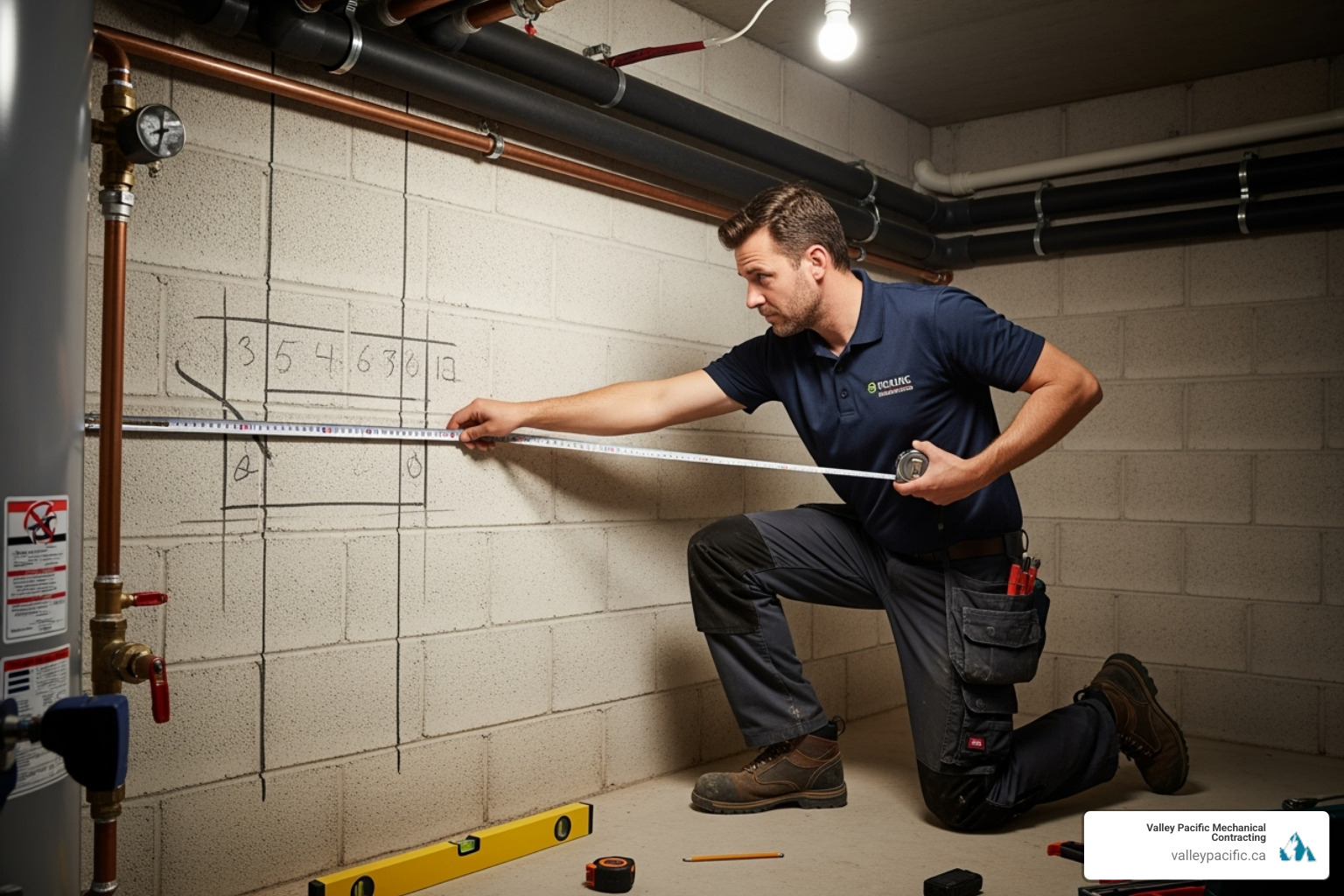
Choosing the Right Location
Finding the right spot for your new boiler involves balancing several factors. Though compact and often wall-mounted, these units require specific clearances for safety and service: typically 18 inches in front, 14 inches at the top, 12 inches at the bottom, and 2 inches on the sides. Many can be installed with zero rear clearance, offering flexibility.
Location restrictions are key. Boilers must be installed indoors. In a garage, they must be mounted at least 18 inches above the floor and protected from vehicles. Closet installations are possible but require proper ventilation. We also consider noise, placing units away from bedrooms for better comfort.
A crucial, often-overlooked factor is proximity to a suitable drain. Convenient drain access for the acidic condensate simplifies installation and reduces costs.
Venting and Combustion Air Requirements
Condensing boilers offer flexible venting options. Unlike traditional boilers needing a chimney, they use a versatile direct vent system. As Category IV appliances, they have positive vent pressure and cool exhaust, allowing for affordable venting materials like PVC, CPVC, polypropylene, or stainless steel.
The direct vent system is a sealed design that draws combustion air from outside and exhausts flue gases through dedicated pipes, improving safety. This also allows for flexible placement, with vent lengths up to 150 feet possible.
Clean combustion air is critical. Sensitive condensing boilers can be damaged by airborne contaminants. We route intake pipes away from sources like:
- Laundry products (bleach, detergents, fabric softeners)
- Paint thinners and solvents
- Cleaning chemicals
- Adhesives and glues
- Antifreeze
- Permanent wave solutions or pool chemicals
Our technicians ensure your system is positioned to receive clean air for optimal performance and longevity.
The Professional Condensing Boiler Installation Process
After planning, the physical condensing boiler installation begins. This complex process requires qualified technicians to manage intricate gas, water, and electrical connections, plus specialized venting and drainage. A single mistake can cause safety hazards or reduce efficiency. Our systematic approach follows proven procedures to ensure your new boiler operates safely and effectively from day one.
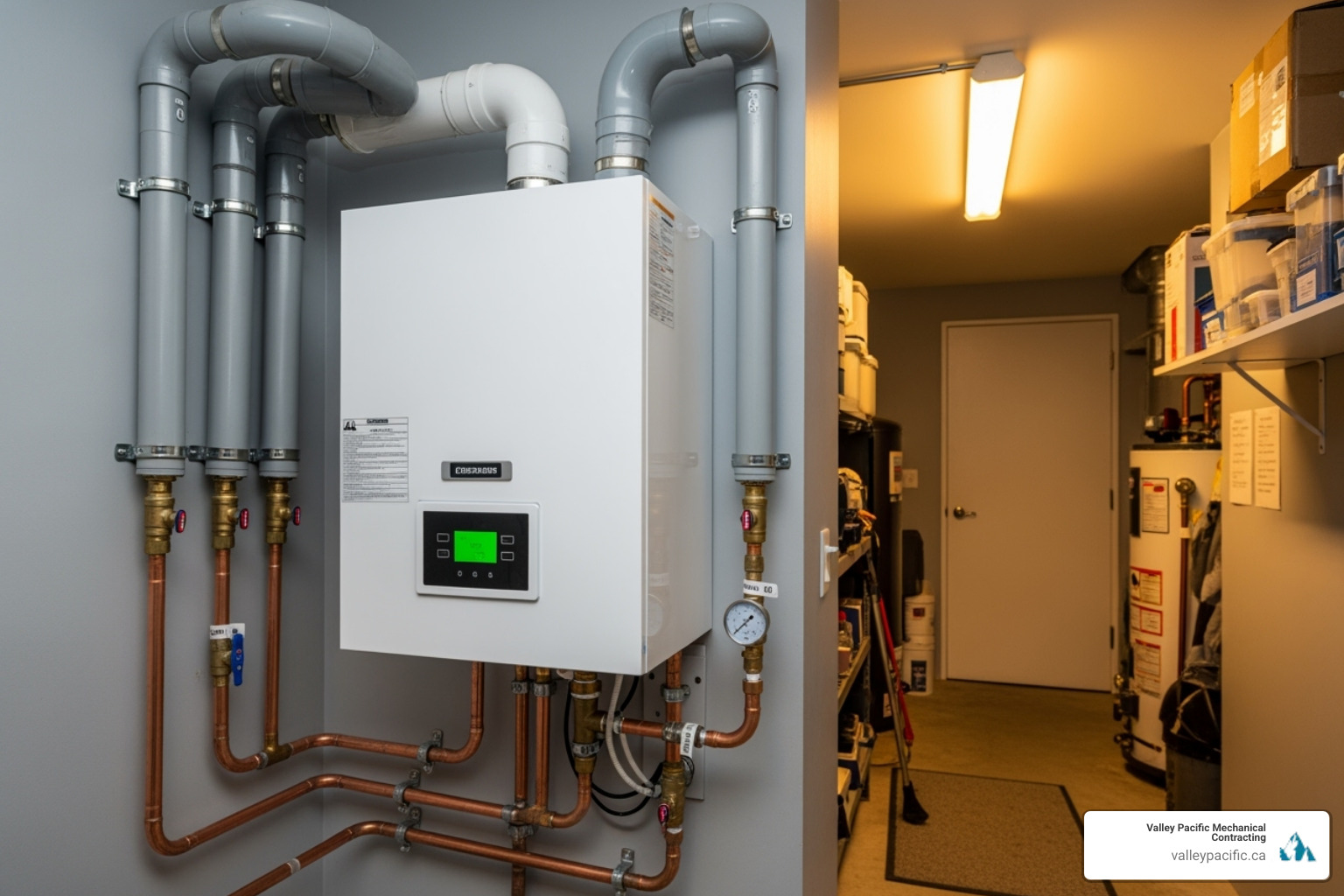
Key Steps in a Condensing Boiler Installation
A successful condensing boiler installation involves several key steps:
- System Flushing: We thoroughly flush the existing heating system to remove sediment and debris that could damage the new boiler's heat exchanger.
- Piping Configurations: We connect the boiler to the water loops, using primary/secondary loops or direct piping to ensure proper flow rates for both the central heating (CH) loop and domestic hot water (DHW) loop.
- Water Connections: We link the boiler to the water supply and heating system, installing backflow preventers and expansion tanks.
- Gas Supply Connection: The gas line is correctly sized and connected according to code, followed by rigorous leak testing.
- Electrical Wiring: We connect the boiler to its power supply and all low-voltage controls like thermostats and sensors.
- Venting System Installation: Approved PVC or CPVC pipes are routed for air intake and exhaust per manufacturer and local codes.
- Condensate Drainage & Testing: We set up the drainage system and perform comprehensive tests to ensure safe, correct operation. Our team provides expert boiler installation in Maple Ridge BC and throughout the Lower Mainland.
Managing Condensate: A Critical Step
Condensing boilers produce condensate, a slightly acidic liquid (pH 3-5) that requires careful management to prevent corrosion of drain pipes.
We install a condensate drain using acid-resistant PVC, directing it to a floor drain or sink. For disposal into municipal sewers, we often add neutralization kits that use alkaline materials to raise the condensate's pH to a safe level. If gravity drainage isn't an option, a condensate pump is installed.
We also focus on preventing frozen condensate lines, which can shut down your boiler. This is done by routing pipes through heated spaces, insulating them, or using heat trace cables. If you notice a leak, our guide on boiler leaking water can help.
Essential Safety Components
Every condensing boiler installation includes essential safety components to protect your home and family.
- Pressure Relief Valves (PRV): Automatically release excess pressure if it exceeds safe limits (typically 30 psi), preventing damage to the boiler and pipes.
- Expansion Tanks: Accommodate the expansion of water as it heats, maintaining safe system pressure.
- Low Water Cut-Off: Shuts down the boiler if water levels drop too low, protecting the heat exchanger from overheating.
- Backflow Preventers: Ensure that heating system water cannot contaminate your potable drinking water supply.
- Air Elimination Devices: Continuously remove trapped air from the system to prevent noise, improve efficiency, and reduce corrosion.
Promptly addressing boiler pressure issues is crucial for maintaining safety and performance.
Optimizing and Maintaining Your New Boiler
A new condensing boiler installation is just the beginning. Proper settings and regular care are needed to maintain the efficiency and comfort you invested in. Modern condensing boilers are reliable when maintained, and our boiler repair Langley guide can help with any issues.
Achieving Peak Performance with Proper Controls
A condensing boiler's efficiency depends on keeping the return water temperature low (ideally below 55°C or 131°F) to enable condensation. We use several controls to achieve this:
- Outdoor Reset Controls: Automatically adjust the boiler's operating temperature based on the weather, running cooler on mild days and hotter in deep winter for optimal efficiency.
- Modulating Burners: Instead of a simple on/off cycle, these burners adjust their output to precisely match your home's heating demand, preventing energy waste and temperature swings.
- Smart Thermostats: Learn your routines to optimize heating schedules, pre-heating your home when needed and saving energy when you're away.
Ensuring Longevity with Water Quality and Maintenance
Proper water quality is crucial for the boiler's heat exchanger. Poor chemistry can cause scale buildup or corrosion, reducing efficiency and lifespan. We monitor water chemistry (hardness, pH 6.5-8.5, minerals) for both the central heating (CH) and domestic hot water (DHW) loops, recommending scale prevention where needed.
Annual professional servicing is essential. Our technicians inspect combustion, clean the heat exchanger, and test safety devices to catch small issues early.
Modern boilers have built-in freeze protection, activating the pump and burner at low temperatures to prevent damage. We also ensure the rest of your system is protected with proper insulation. If you notice pressure changes, our guide on what to do when boiler pressure drops can help.
Frequently Asked Questions about Condensing Boiler Installation
After thirty years of helping Lower Mainland homeowners upgrade their heating systems, we've heard just about every question you can imagine about condensing boiler installation. Here are the ones that come up most often during our consultations.
Is a combi-boiler the same as a condensing boiler?
No, they are different concepts that often overlap.
- "Condensing" describes how a boiler works: it uses technology to capture extra heat from exhaust for 90%+ efficiency.
- "Combi" (combination) describes what a boiler does: it provides both central heating and instant hot water from a single unit.
While most new combi-boilers are condensing, not all condensing boilers are combis. Other options include:
- System boilers: Work with a separate hot water tank, ideal for homes with high hot water demand.
- Regular (heat-only) boilers: A traditional setup that heats radiators and uses a separate hot water cylinder.
We help you choose the right type for your home's needs. If you have issues, see our guide on troubleshooting no hot water from boiler.
How does high elevation affect a condensing boiler installation?
Higher elevations in the Lower Mainland present unique challenges for a condensing boiler installation. The air is thinner at altitude, meaning there is less oxygen available for combustion. This disrupts the required fuel-to-air ratio for safe and efficient operation.
To compensate, manufacturers provide de-rating instructions that require reducing the boiler's maximum output. For example, a boiler's capacity might be reduced by 10% at 3,000 feet. This precise adjustment must be performed by a qualified technician familiar with high-elevation installations to ensure your boiler runs safely and efficiently.
What happens if my old boiler is removed from a shared chimney?
This is a common situation in older buildings with shared chimney systems. Removing an old boiler changes the venting dynamics for the remaining appliances.
We first properly seal the opening left by the old boiler. More importantly, a professional must inspect the other appliances (like a water heater) still using the chimney to ensure they continue to vent safely with proper draft. While your new condensing boiler will have its own modern, dedicated direct-vent system, we ensure the shared chimney remains safe for any other connected appliances.
Conclusion
The shift towards high-efficiency condensing boilers represents more than just a technological upgrade—it's a smart investment in your comfort, your wallet, and our environment. With their remarkable ability to achieve efficiencies of 90% or higher, these systems deliver substantial benefits that you'll notice from day one: lower energy bills, a reduced carbon footprint, and that reliable, consistent warmth that makes a house feel like home.
The upcoming regulations requiring 90% efficiency for commercial installations starting in 2025 aren't just bureaucratic red tape—they're recognition that condensing boilers have become the gold standard for heating. When regulations catch up to technology, you know you're making the right choice.
But here's the thing: all those impressive efficiency numbers and environmental benefits only matter if your condensing boiler installation is done right. This isn't a weekend DIY project or a job for just any contractor. From understanding the intricate dance of latent heat recovery to properly managing that acidic condensate, from ensuring your venting meets strict safety codes to calibrating controls for peak performance—every detail matters.
That's where the difference between a good installation and a great one becomes crystal clear. A poorly installed condensing boiler might still heat your home, but it won't deliver the efficiency you paid for, and it certainly won't give you the peace of mind you deserve.
At Valley Pacific Mechanical Contracting, we've built our reputation on one simple promise: providing a truly headache-free experience for all your heating needs. With over 30 years of hands-on expertise serving the Lower Mainland and our 24/7 emergency service, our certified technicians approach every condensing boiler installation with the precision and care it demands. We don't just install equipment—we create heating solutions that work flawlessly for years to come.
Whether you're in Langley, Maple Ridge, Mission, Pitt Meadows, Coquitlam, or anywhere across the Lower Mainland, we're here to ensure your investment in high-efficiency heating pays dividends in comfort and savings. Because when it comes to keeping your family warm, you shouldn't have to worry about whether it was done right.
Ready to experience the difference that professional installation makes? For expert condensing boiler installation in Langley and the surrounding Lower Mainland, contact our team today!




